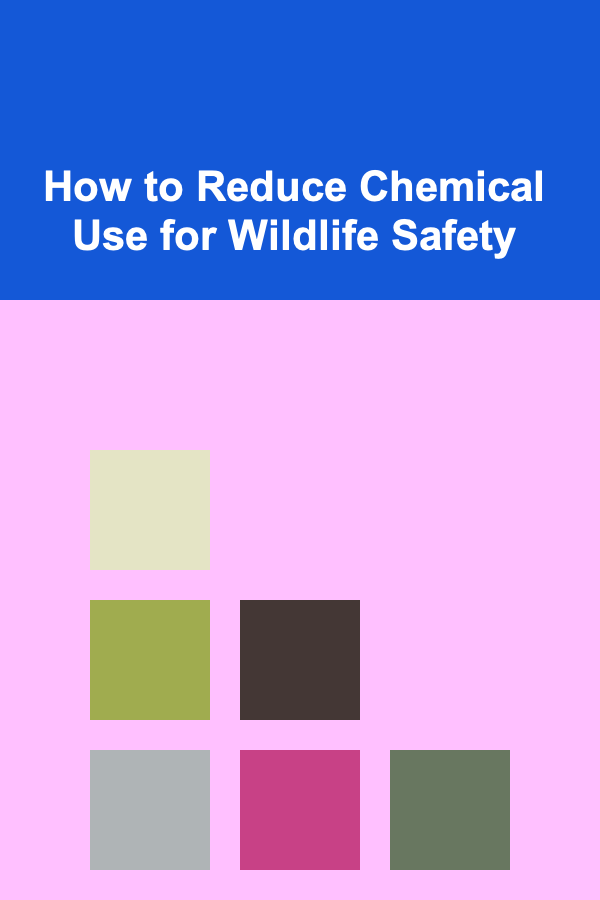
How to Reduce Chemical Use for Wildlife Safety
ebook include PDF & Audio bundle (Micro Guide)
$12.99$6.99
Limited Time Offer! Order within the next:

The protection of wildlife has become an urgent matter as human activity continues to affect ecosystems in profound ways. One of the most concerning impacts is the use of chemicals in agriculture, pest control, and industrial processes, which can endanger wildlife by contaminating their habitats and food sources. From pesticides to industrial runoff, these chemicals can have devastating consequences for animals and their environments. In this article, we will explore practical approaches to reducing chemical use for wildlife safety, looking at the environmental, economic, and ethical reasons behind this movement. We will also examine various strategies for minimizing chemical exposure, from sustainable farming practices to regulatory changes.
The Impact of Chemical Use on Wildlife
Before delving into strategies for reducing chemical use, it is crucial to understand the ways in which chemicals affect wildlife.
1. Pesticides and Herbicides
Pesticides, herbicides, and fungicides are commonly used in agricultural practices to protect crops from pests and diseases. However, these chemicals often extend beyond their intended targets, affecting non-target organisms, including wildlife.
- Toxicity to Animals: Many pesticides are highly toxic to insects, birds, mammals, and aquatic life. For instance, the use of neonicotinoids has been linked to declines in bee populations, which play a crucial role in pollination. Similarly, herbicides like glyphosate have been shown to harm amphibians and aquatic invertebrates when they leach into water bodies.
- Bioaccumulation and Biomagnification: Some chemicals accumulate in the tissues of animals, a process known as bioaccumulation. As these chemicals move up the food chain, they become more concentrated, a phenomenon called biomagnification. This can result in high toxicity levels for top predators such as eagles, hawks, and even humans.
- Disruption of Reproductive Systems: Certain chemicals, such as endocrine disruptors, interfere with the hormonal systems of wildlife. These chemicals can cause reproductive failures, deformities, and changes in behavior, leading to population declines.
2. Industrial Chemicals and Pollution
Industrial chemicals, including heavy metals, oils, and other pollutants, can have severe consequences for wildlife when released into the environment. These pollutants often find their way into water bodies, where they can poison aquatic life or enter the terrestrial food chain.
- Oil Spills: Oil spills are one of the most notorious forms of industrial pollution, devastating marine life. Animals such as sea otters, birds, and fish can suffer from skin burns, respiratory issues, and poisoning when exposed to crude oil or its derivatives.
- Heavy Metals: Metals like mercury and lead are persistent environmental pollutants that can harm wildlife when they accumulate in water bodies and soil. For example, mercury poisoning in fish has been linked to neurological damage in birds and mammals that consume these fish.
- Toxic Runoff: Chemical runoff from agricultural fields, urban areas, and industrial facilities can contaminate rivers and lakes, affecting wildlife that depends on these ecosystems for survival. Nutrient runoff, primarily nitrogen and phosphorus, causes eutrophication, leading to oxygen-deprived "dead zones" in bodies of water, which are inhospitable for aquatic life.
3. Pharmaceuticals and Personal Care Products
Pharmaceuticals and personal care products, such as antibiotics, hormones, and fragrances, are increasingly detected in the environment, particularly in water systems. These chemicals can disrupt the behavior and health of wildlife, especially aquatic organisms.
- Antibiotics in Waterways: The runoff of antibiotics from farms and wastewater treatment plants has contributed to the development of antibiotic-resistant bacteria, which can affect the health of wildlife and humans alike. Aquatic organisms, particularly fish, can be directly affected by these pharmaceuticals, causing abnormalities in growth and reproduction.
- Hormones and Endocrine Disruption: The presence of synthetic hormones, such as those found in birth control pills and other medications, in water systems has been linked to altered reproductive cycles in fish, amphibians, and other wildlife. These chemicals interfere with the endocrine systems of animals, leading to altered behaviors and diminished populations.
Reducing Chemical Use: Approaches for Wildlife Safety
Given the profound impact that chemicals can have on wildlife, it is critical to implement strategies that reduce their use and mitigate their effects on ecosystems. Below are several effective approaches to reducing chemical use for wildlife safety.
1. Sustainable Agricultural Practices
Agriculture is one of the largest sources of chemical pollutants, yet it is also a sector where significant changes can be made to reduce chemical use. By transitioning to sustainable practices, farmers can minimize their reliance on harmful chemicals while maintaining productivity.
- Organic Farming: Organic farming practices restrict the use of synthetic pesticides, herbicides, and fertilizers. Instead, organic farmers rely on natural pest control methods, crop rotation, and soil health management techniques to control pests and improve soil fertility. Organic farms are typically more biodiversity-friendly, providing better habitats for wildlife and supporting healthier ecosystems.
- Integrated Pest Management (IPM): IPM is an approach that combines biological, physical, and chemical tools to manage pests in a way that minimizes harm to the environment. By using biological pest control agents, such as predators or parasites, and employing non-chemical methods like crop rotation, farmers can reduce their dependence on chemical pesticides.
- Agroforestry and Polyculture: Agroforestry and polyculture systems promote biodiversity by planting multiple types of crops alongside trees and shrubs. This reduces the need for chemical inputs, as these systems are more resilient to pests and diseases. These practices also provide wildlife habitats and help preserve soil and water quality.
2. Eco-Friendly Alternatives to Chemicals
In some cases, it is possible to replace harmful chemicals with safer, eco-friendly alternatives that pose less risk to wildlife.
- Biological Control: The use of natural predators or parasites to control pests has become an effective and environmentally friendly alternative to chemical pesticides. For example, releasing ladybugs to control aphids or introducing parasitic wasps to control caterpillar populations can help reduce the need for synthetic pesticides.
- Plant-Based Solutions: Some plant-based products, such as neem oil and diatomaceous earth, can be used as natural pest control agents. These alternatives are generally less toxic to non-target species and can be integrated into organic farming systems.
- Beneficial Microorganisms: The use of beneficial microorganisms, such as bacteria or fungi, can help manage soil health and control pests without the need for chemical treatments. For example, Bacillus thuringiensis (Bt) is a soil bacterium that targets specific insect pests and is often used as a safer alternative to chemical insecticides.
3. Reforestation and Habitat Restoration
Another key strategy in reducing chemical exposure to wildlife is through habitat restoration and reforestation. By restoring degraded ecosystems, we can create environments that are more resilient to chemical pollution and better able to support diverse wildlife populations.
- Wetland Restoration: Wetlands are critical ecosystems that help filter pollutants from water, but they have been severely degraded by urban development and agriculture. Restoring wetlands can help remove chemicals from the environment, reducing the exposure of wildlife to harmful substances.
- Forest Restoration: Deforestation and forest fragmentation have disrupted habitats for countless species. By reforesting areas and maintaining habitat corridors, we can reduce the pressure on wildlife and improve biodiversity.
4. Stronger Regulatory Frameworks
One of the most effective ways to reduce chemical use on a large scale is through stronger environmental regulations and policies. Governments can play a key role in reducing chemical exposure to wildlife by enacting and enforcing laws that limit harmful chemical usage and promote safer alternatives.
- Pesticide Regulations: Governments should enforce stricter regulations on pesticide use, ensuring that chemicals are tested for their environmental impact before they are approved for use. Additionally, restrictions on the application of pesticides in sensitive areas, such as near water bodies or wildlife habitats, can help protect wildlife from exposure.
- Pollution Control: Stricter pollution control measures, such as tighter regulations on industrial discharges and wastewater treatment, can help reduce the amount of chemicals released into the environment. Governments can incentivize industries to adopt cleaner technologies and encourage more sustainable practices.
- Subsidies for Sustainable Practices: To support farmers and industries in transitioning to more sustainable practices, governments can provide subsidies for organic farming, IPM, and other eco-friendly alternatives. This can help offset the initial costs of adopting these practices and encourage broader adoption.
5. Public Awareness and Education
Raising public awareness about the importance of reducing chemical use for wildlife safety is essential for fostering change at the grassroots level. By educating consumers, farmers, and industries about the risks of chemical pollution, we can create a culture of environmental responsibility.
- Educational Campaigns: Public campaigns that highlight the connection between chemical use and wildlife safety can motivate individuals to make more eco-conscious choices. These campaigns can focus on topics such as sustainable agriculture, organic food, and the impacts of chemical pollution on local wildlife.
- Citizen Science: Encouraging people to participate in citizen science programs, such as monitoring wildlife populations or tracking pollution levels, can increase public engagement and foster a deeper understanding of environmental issues.
Conclusion
Reducing chemical use is critical for the protection of wildlife and the preservation of ecosystems. By adopting sustainable agricultural practices, exploring eco-friendly alternatives, and implementing stronger regulatory frameworks, we can mitigate the harmful impacts of chemicals on wildlife. Moreover, through habitat restoration, public education, and increased awareness, we can build a more sustainable future for both wildlife and human society. Reducing chemical exposure is not only an environmental issue but also an ethical responsibility to protect the biodiversity that sustains life on Earth.

How to Handle Property Maintenance Requests from Tenants
Read More
How to Invest in Stocks for Beginners: A Step-by-Step Guide
Read More
How to Plan a Seasonal Refresh for Your Wellness Area
Read More
How to Start a Side Hustle with Deep Learning for Passive Income
Read More
How to Use Multi-Purpose Containers for Small Item Storage
Read More
How to Utilize Hidden Storage in Your Furniture for More Space
Read MoreOther Products

How to Handle Property Maintenance Requests from Tenants
Read More
How to Invest in Stocks for Beginners: A Step-by-Step Guide
Read More
How to Plan a Seasonal Refresh for Your Wellness Area
Read More
How to Start a Side Hustle with Deep Learning for Passive Income
Read More
How to Use Multi-Purpose Containers for Small Item Storage
Read More